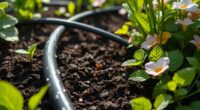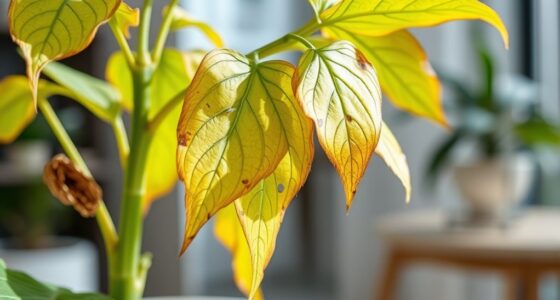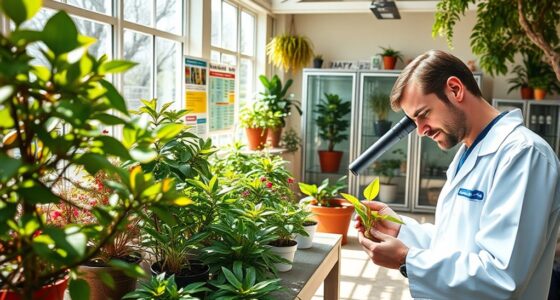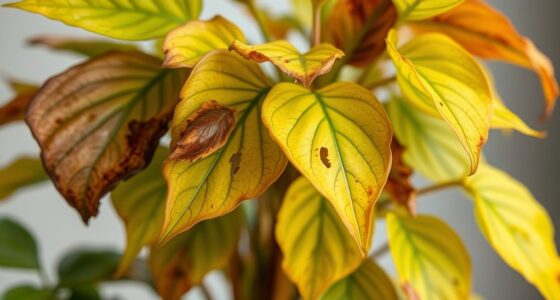If your plant shows yellowing leaves, it might be overwatering or underwatering. Wilting, crispy edges, or stunted growth can also point to watering issues. Pests like tiny insects, webbing, or sticky residue suggest infestations. Discolored spots or holes indicate pest or disease problems. Regularly inspect your plant for these signs, and take action quickly. Staying vigilant helps keep your plant healthy; discover more tips to fix common issues.
Key Takeaways
- Observe leaf color and texture for signs of overwatering, underwatering, or pest damage.
- Check soil moisture and drainage to identify watering issues causing yellowing or wilting.
- Look for pests like aphids, spider mites, or mealybugs on leaves and undersides.
- Detect symptoms such as holes, webbing, spots, or sticky residue indicating pest or disease problems.
- Regularly inspect plants for early signs like curling, browning, or stunted growth to prevent further damage.
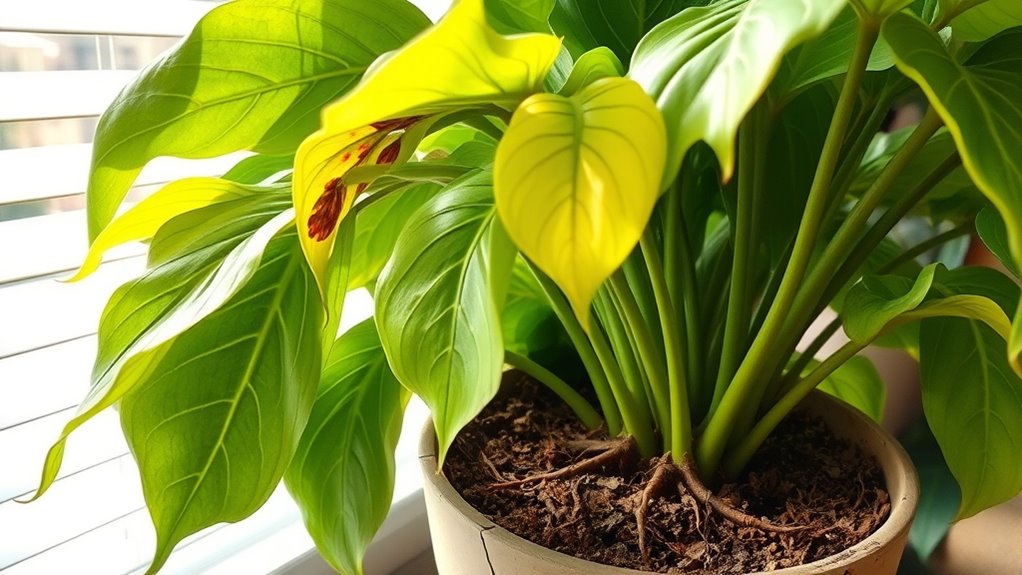
Whether you’re a seasoned gardener or just starting out, identifying common plant problems is essential for keeping your plants healthy. One of the first clues to diagnose issues is observing watering problems. Overwatering can lead to root rot, causing leaves to yellow and wilt despite moist soil. Underwatering, on the other hand, results in dry, crispy leaves and stunted growth. To prevent these issues, check the soil moisture regularly, and adjust your watering schedule accordingly. Remember, many plants prefer consistent watering, but the exact needs vary; some thrive in moist soil, while others prefer drier conditions. When you notice symptoms like wilting or discoloration, inspect the soil before watering again. If the soil feels soggy, hold off; if it’s dry, give your plant a thorough soak. Proper watering techniques are crucial for maintaining plant health.
Pest identification is another critical step in diagnosing plant problems. Pests can cause a range of issues, from chewed leaves to distorted growth and sticky residue. Common pests like aphids, spider mites, and mealybugs often hide on the undersides of leaves or along stems. Look for telltale signs such as holes in leaves, webbing, or clusters of small insects. Early pest detection allows you to act quickly, preventing infestations from spreading and causing further damage. You can often identify pests by their appearance and the damage they leave behind. Using a magnifying glass can help you spot tiny pests, while sticky traps or checking under leaves can reveal hidden invaders. Once identified, you can choose appropriate treatments—whether organic insecticidal soap, neem oil, or manual removal—to keep pests under control.
Pay attention to your plant’s overall appearance. If leaves are yellowing, curling, or falling off without an obvious reason, it could point to watering issues or pest problems. Conversely, if the plant shows stunted growth, spots, or unusual markings, it might be affected by pests or diseases. Regularly inspecting your plants, especially during seasonal changes, helps you catch problems early. Maintaining proper watering habits and staying vigilant for pests creates a strong foundation for healthy plants. Additionally, understanding how air quality filters can reduce airborne pollutants can help in creating a healthier environment for both your plants and yourself. When you become familiar with these signs, you’ll find it easier to diagnose issues accurately and respond promptly. Ultimately, understanding watering issues and pest identification empowers you to troubleshoot effectively, ensuring your plants thrive rather than struggle.
Frequently Asked Questions
How Often Should I Water Different Types of Houseplants?
When figuring out your watering schedule, it’s important to contemplate each plant’s specific needs. Check moisture levels regularly—stick your finger into the soil about an inch deep, and water only when it feels dry. For some plants, like succulents, you might water once every few weeks, while others need weekly watering. Adjust your routine based on your plant’s environment and always monitor moisture levels to keep them healthy.
What Soil Is Best for My Specific Plant?
You might notice that choosing the right soil feels like a coincidence, but it’s actually about understanding your plant’s needs. For your specific plant, opt for soil with the correct soil pH—slightly acidic or neutral often works well—and good soil drainage to prevent waterlogging. These factors help your plant thrive, avoiding problems like root rot or nutrient deficiencies. So, match the soil to your plant’s preferences for healthier growth.
How Can I Prevent Pests From Attacking My Plants?
To prevent pests from attacking your plants, start with pest identification to know which pests you’re dealing with. Keep your plants healthy, as strong plants resist pests better. Use organic pest control methods like neem oil or insecticidal soap, avoiding harsh chemicals. Regularly inspect your plants for early signs of pests, and remove any affected leaves promptly. This proactive approach helps protect your plants naturally and keeps pests at bay.
When Should I Repot My Plant for Optimal Growth?
You should repot your plant when it outgrows its current pot or shows signs like roots spilling out or circling the pot’s surface. Don’t worry—re-potting isn’t stressful if you use fresh potting mix. Repotting helps maintain root health and encourages growth. Ideally, do this during the plant’s active season, usually spring or early summer, to give it the best chance for strong, healthy development.
Are There Natural Remedies for Plant Disease?
You can tackle plant diseases with natural solutions by trying organic treatments and DIY remedies. For example, neem oil acts as a natural fungicide and insect repellent, while homemade garlic or onion sprays can help keep pests at bay. Regularly removing infected leaves and improving air circulation also supports plant health. These eco-friendly options are gentle on your plants and the environment, making them effective and sustainable solutions.
Conclusion
Just like a seasoned detective solving a mystery, you can uncover your plant’s secrets by paying close attention. Recognize the subtle signs, trust your instincts, and act swiftly. Remember, every healthy plant was once a tiny seed full of potential—nurture it with patience and care. With a little practice, you’ll master the art of diagnosis, turning your garden from a battlefield into a lush paradise. After all, even Hercules started with small steps.

